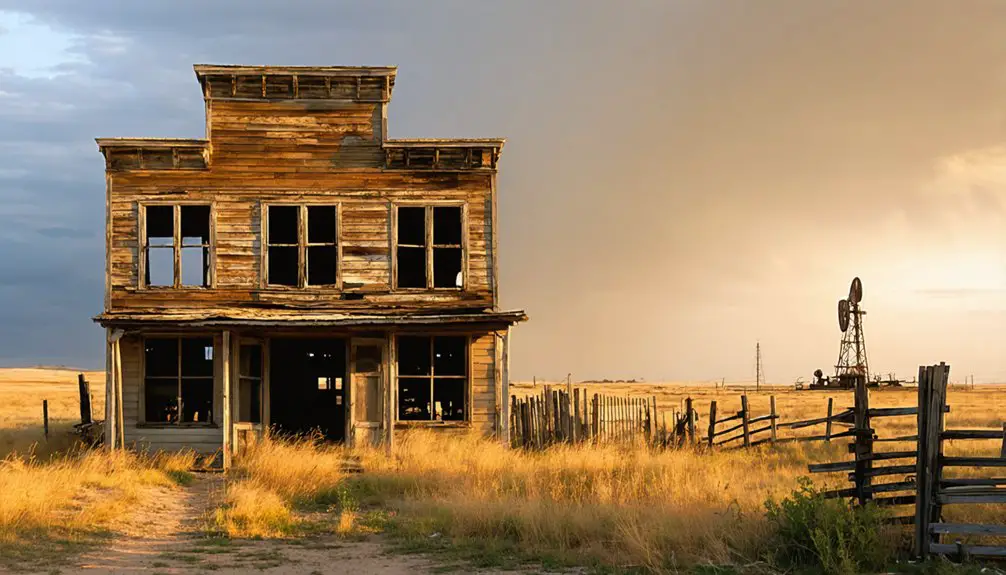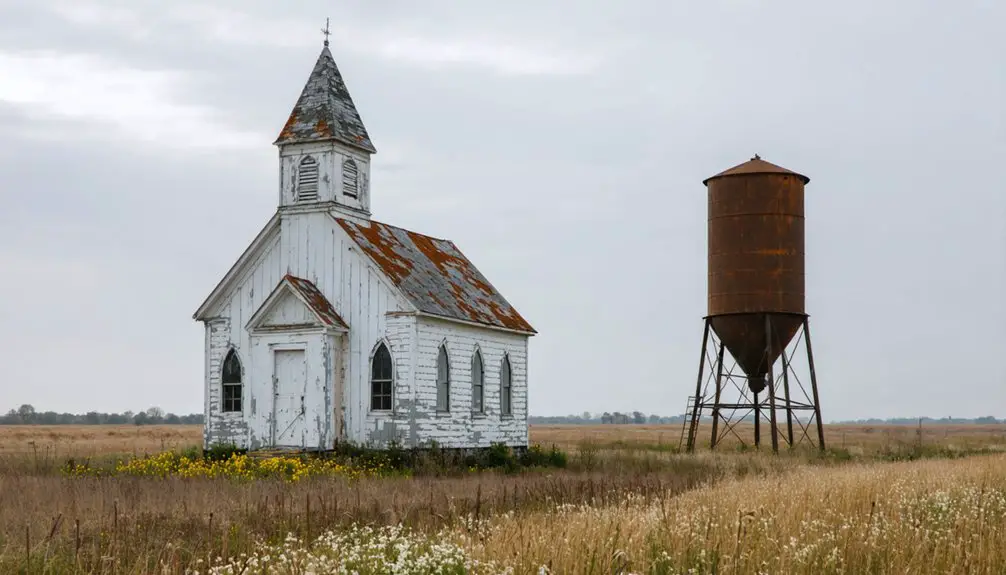You’ll find Avoca’s ghost town origins near Wewaukee Springs, where Seminole Indians and white settlers created a vibrant community in the late 1800s. The town, named from a Seminole term meaning “tumbling water,” thrived with general stores, a sawmill, and cotton gins. When the “Old Beck” railroad bypassed Avoca in 1901 and the post office relocated to Asher, the town’s fate was sealed. Its transformation from frontier hub to abandonment tells a fascinating tale of Oklahoma Territory life.
Key Takeaways
- Avoca began as Wewaukee Springs in the late 19th century, named from Seminole terms meaning “tumbling water” or “gathering place.”
- The town thrived with general stores, a sawmill, cotton gin, and blacksmith shop until transportation routes bypassed it in 1901.
- Relocation of the post office to Asher in 1901 severely impacted commerce, leading to Avoca’s eventual abandonment.
- The “Old Beck” railroad’s decision to bypass Avoca triggered business migration to Asher, accelerating the town’s decline.
- By 1906, Avoca was described as “about abandoned” following the permanent closure of its post office.
Early Settlement and Frontier Life
As settlers pushed into Oklahoma Territory in the late 19th century, the community of Avoca emerged from what was originally called Wewaukee Springs, a name derived from the Seminole term for “tumbling water.” The settlement developed along a vital east-west “Wagon Road,” which facilitated trade and travel through the territory. Like many place name settlements, Avoca became one of numerous frontier communities that dotted the Oklahoma landscape.
You’d have found a diverse mix of Seminole Indians and white settlers in early Avoca, with the population shifting to mainly Pottawatomi Indians by 1910. Similar to Pleasant Prairie Community, Pottawatomi families were integral to shaping the early character of the settlement.
Frontier education took root in 1892 with the establishment of the first school near what’s now Avoca Cemetery, where educators like J.C. Fisher and B.C. Klepper shaped young minds.
The pioneering spirit of Avoca’s first educators laid the foundation for learning, nurturing frontier children’s minds near the historic cemetery grounds.
Community governance evolved through the efforts of entrepreneurs who often served dual roles as civic leaders, while early professionals like teachers, lawyers, and doctors helped build the settlement’s social framework.
The Origins of the Town Name
The mystery behind Avoca’s name reflects two compelling origin stories that have endured through generations.
You’ll find the first interpretation stems from Native American heritage, suggesting it means “the gathering place,” while the second draws from Irish roots, translating to “where the bright waters meet” from the Vale of Avoca.
Before the Rock Island Railroad’s arrival in 1869, locals knew the area as Wewaukee Springs, a Seminole phrase meaning “tumbling water.”
The name’s significance captures both the physical landscape and cultural heritage of the region, where Seminole and Pottawatomi tribes once dwelled. According to local history, Mr. Peel’s wife was responsible for choosing the town’s name.
When settlers established the town, they transformed it from its Native American origins, choosing Avoca – a name that symbolized both the area’s natural water features and its destiny as a community crossroads.
Economic Growth and Development
You’ll find that Avoca’s early economic foundations centered on R. Perkins’s general store, which served as the primary trading hub for the growing settlement. Similar to other family-run businesses established by Potawatomi entrepreneurs, it became vital to the community’s stability.
The village also featured a bustling steam-powered sawmill that provided essential lumber processing for construction and trade.
Vital services expanded with M.F. Merrill’s blacksmith shop providing critical metalworking and tool repairs for the agricultural community.
A cotton gin, built by A. Rutherford and J.B. Buckler, supported local cotton farmers by processing their harvests efficiently, establishing Avoca as a frontier business center.
Trade and Essential Services
During the early 1900s, trade and essential services played a pivotal role in Avoca’s economic trajectory, with the town’s fate ultimately tied to shifting transportation routes and infrastructure development.
You’d have found bustling general stores, cotton gins, and blacksmith shops serving both residents and travelers who stopped at Wewaukee Springs. However, when the railroad extended to Asher in 1901, trade routes dramatically shifted away from Avoca. Like many Oklahoma settlements impacted by railroad routing changes, the town’s prominence as a trade center diminished significantly.
The relocation of the post office to Asher dealt another crushing blow to Avoca’s commerce. While you could’ve witnessed a brief revival when postal services returned in 1902, it wasn’t enough to stem the service decline. Much like the lead mining boom that transformed Picher into a thriving city of 20,000 residents in the 1920s, Avoca’s growth depended heavily on economic opportunities.
Businesses and residents followed the railroad’s path to Asher, where better transportation access promised greater economic opportunities. This exodus left Avoca with little more than a church and cemetery.
Frontier Business Foundations
At its founding, Avoca’s business landscape took shape through pioneering entrepreneurs who established core commercial ventures. R. Perkins opened the first general store, creating an essential hub for frontier commerce where settlers could obtain necessary supplies.
The establishment of A. Rutherford and J.B. Buckler’s cotton gin marked a significant step in agricultural innovation, enabling local farmers to process their cotton harvests efficiently.
M.F. Merrill’s blacksmith shop provided important metalworking services that supported both farming operations and wagon traffic along the east-west trade route.
The town’s strategic location near Wewoka Springs attracted steady traffic, while its position along a major wagon road guaranteed consistent trade flow.
These foundational businesses formed the backbone of Avoca’s early economy, serving both the local community and travelers passing through the frontier settlement.
Social Dynamics and Cultural Mix
You’ll find Avoca’s frontier law and order centered around informal community standards rather than structured law enforcement, reflecting its small rural character.
The town’s social dynamics revolved primarily around its European-descended settler population, with little documented interaction between Native American communities and settlers in township records.
While neighboring towns sometimes struggled with lawlessness and vice, Avoca maintained a relatively peaceful atmosphere through its church-centered social structure and agricultural focus. Unlike towns such as Blackburn which gained notoriety as a whiskey town, Avoca stayed clear of the liquor trade controversy.
Frontier Law and Order
As Oklahoma’s frontier towns developed, Avoca’s law enforcement system reflected the complex social dynamics typical of settlements in the region.
You’d find law enforcement adapting to serve multiple roles, managing both civil policing and jail operations with limited resources. The town’s diverse population of settlers, traders, and transient workers created unique challenges in maintaining social order. Like other frontier jurisdictions, officers had to maintain public transparency records of incidents and investigations. Similar to West Orange’s General McClellan’s influence on local affairs, prominent figures shaped how justice was administered.
Local law officers had to navigate cultural differences and language barriers while relying heavily on informal negotiations and community consensus to resolve disputes.
The town’s supply intersections became essential spots where information flowed and justice was often deliberated outside formal channels. When conflicts arose over land use or personal honor, officers balanced strict enforcement with diplomatic solutions, adapting their approach to the town’s multicultural environment.
Native-Settler Community Relations
The original Seminole name “Wewaukee Springs” provides a window into Avoca’s complex Native-settler relations during the mid-19th century. The village emerged as a mixed community where cultural exchange between Native Americans and white settlers shaped daily life, though underlying tensions over land ownership remained.
The community’s dynamics were marked by:
- Initial coexistence between Seminoles and settlers along the Wagon Road
- Shift to Pottawatomi presence by 1910 as Seminoles moved away
- Shared use of community institutions like the Avoca School
- Adaptation to farming-based economies under federal policies
Despite some cooperation in trade and education, the broader context of Indian Removal policies and the Dawes Act gradually shifted power away from Native tribes, transforming the social fabric of early Avoca into a mainly settler community.
Local Businesses and Services

Local commerce in Avoca centered around essential businesses that served both residents and travelers during the town’s brief period of prosperity.
R. Perkins’ general store anchored the community’s business district, while M.F. Merrill’s blacksmith shop and the cotton gin operated by Rutherford and Buckler supported the agricultural backbone of the region.
The town’s business viability relied heavily on the post office, which acted as a crucial communication hub until its controversial relocation to Asher in 1901.
You’ll find that community reliance on these core services became evident as their departure triggered a rapid economic decline.
The Era of Lawlessness
While the town’s businesses struggled to maintain order, Avoca faced challenges typical of frontier settlements during the late 19th century. Located near Wewaukee Springs, the town’s position attracted transient populations and exposed it to the lawlessness common in Oklahoma Territory’s borderlands.
Law enforcement challenges were particularly evident in Avoca due to:
- Weak governmental infrastructure during early settlement years
- Its location between Oklahoma and Indian Territories, creating jurisdictional confusion
- The presence of informal economic activities alongside legitimate businesses
- The influx of travelers and temporary workers drawn to the springs
The town’s struggles with maintaining order intensified after the unauthorized relocation of its post office and store, which diminished official oversight.
While no major violent incidents were documented, Avoca’s isolation and limited governance made it vulnerable to the disorder typical of frontier settlements.
Factors Leading to Abandonment

Following its brief period of frontier development, Avoca’s decline accelerated rapidly after 1901 when the “Old Beck” rail spur bypassed the settlement in favor of nearby Asher.
The railroad’s decision to bypass Avoca for Asher in 1901 marked the beginning of the frontier town’s swift demise.
The railroad impact proved devastating as businesses and residents migrated to the newly established rail hub, leaving Avoca’s once-bustling streets increasingly empty.
The unauthorized service relocation of the post office to Asher in late 1901 dealt another severe blow to Avoca’s viability.
You can trace the town’s final descent through newspaper accounts that by 1903 described it as “about abandoned.”
Without its post office, general store, and other essential services, Avoca couldn’t compete with Asher’s growing prominence.
The town’s permanent post office closure in 1906 marked the final chapter in its transformation from a promising settlement to another Oklahoma ghost town.
What Remains Today
Today’s visitors to Avoca’s original townsite will find sparse remnants of its frontier past. The Church of Christ stands as one of the few current landmarks among scattered residential homes and the historic cemetery. The surrounding area has largely returned to rural activities, with agricultural land dominating the landscape.
While formal historical markers are absent, you’ll discover:
- The original town layout, though most foundations are now reclaimed by nature
- A quiet cemetery preserving the community’s heritage
- Agricultural fields where businesses once operated
- Natural vegetation that’s steadily overtaken abandoned lots
The post office’s closure in 1906 marked Avoca’s final decline, and today the site exemplifies the shift from frontier settlement to Oklahoma countryside, with wildlife now inhabiting areas once bustling with human activity.
Frequently Asked Questions
What Was the Average Population of Avoca During Its Peak Years?
When you look at historical demographics and population trends, you’ll find the average peak population was around 3,716 residents during 1900-1920, with the highest point reaching 4,228 in 1910.
Were There Any Notable Natural Disasters That Affected Avoca’s Development?
Like a gentle breeze rather than a storm, there’s no evidence of tornado impact or flood damage affecting Avoca’s development. You won’t find any documented natural disasters in the town’s history.
What Happened to the Original Buildings and Homes of Avoca?
You’ll find no ghostly remnants of original structures today – they’ve vanished through abandonment, natural architectural decay, and residents moving materials to Asher following the 1901 railroad extension and post office relocation.
Did Any Famous Outlaws or Historical Figures Visit Avoca?
Like a blank page in history’s book, you won’t find any outlaw legends or documented historical visits from famous figures during Avoca’s time. Local settlers and entrepreneurs shaped the town’s brief story.
How Did Native American Tribes Influence Local Traditions and Customs?
You’ll find tribal ceremonies shaped local customs through medicine practices, language adoption, and spiritual gatherings, while cultural preservation efforts by the Five Civilized Tribes influenced agriculture, trade, and community traditions.
References
- https://www.fairburynews.net/post/the-ghost-town-of-avoca
- https://en.wikipedia.org/wiki/Avoca
- https://kids.kiddle.co/Avoca
- http://genealogytrails.com/oka/pottawatomie/countyhistory.html
- https://www.okhistory.org/publications/enc/entry?entry=GH002
- https://www.scribd.com/document/90368321/Pottawatomi-County-Oklahoma-History
- https://www.okhistory.org/publications/enc/entry?entry=SE024
- https://www.okhistory.org/publications/enc/entry?entry=PO026
- https://avocaarkansas.info/mobile/about.aspx
- https://www.cityofavoca.com/vnews/display.v/SEC/Live/Work/Play|History of Avoca



